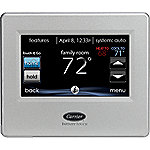HOW TO SET YOUR THERMOSTAT IN THE SUMMER

Running your AC can account for over 50% of your energy bill in the summer months. But remember, you’re the one in control of your thermostat. Here are 3 thermostat-setting steps to help you stay cool and cut costs.
Step 1: Find your comfort limit and use ceiling fans
It’s silly for anyone to tell you an exact degree to set your thermostat. Comfort is unique to everyone. That’s why it’s important for you to know your temperature limit when raising your thermostat to save money. For example: 82° may be way too hot–even with a ceiling fan above you–but 78° is perfect. This may take some time to play around with, but it’s worth it to know this number so you’re able to work around it (hint: step 2). Also, include ceiling fans in your temperature adventure. The fan’s downward breeze has a chilly wind effect that can help cool you down dramatically. In fact, a ceiling fan can “allow you to raise the thermostat setting about 4°F with no reduction in comfort,” according to Energy.gov. But keep in mind fans do not cool rooms, they cool you by evaporating moisture from your skin (the physical action that makes you feel cooler). So, remember to turn fans off when you leave the room.
Step 2: Adjust to fit your schedule
It’s a fact that thermostat setbacks save energy and money. So, now that you know your exact comfort setting, you can adjust that temperature daily before you leave the house and when you go to sleep at night. Typically, raising your thermostat by 5 to 8° can help reduce energy costs. More specifically, Energy Star recommends raising your temperature at least 7° when you’re away from your home during the day and 4° when you’re asleep. General rule of thumb: the smaller the difference between the indoor and outdoor temperatures, the lower your overall cooling bill will be. Learn more about thermostat setbacks. Want an easier way? A programmable thermostat helps you do this automatically. Through proper use, a programmable thermostat can save you roughly $180 every year in AC costs.
Step 3: Ensure proper thermostat location
The location of your thermostat is very important. To operate properly, your thermostat should be placed on a wall in a central area of your home and away from:
- Direct sunlight
- Doorways with major drafts
- Skylights
- Windows
- Furniture (directly in front or below it)
These can trigger your AC to cycle when it doesn't need to and in turn, cost you money. Want more great tips like these? Join our newsletter and get great tips like these delivered straight to your inbox. You can also check out our other air conditioning articles. Ragsdale has been serving the metro Atlanta area for over 25 years. Contact us online for more information on how we can help you.
Related Reading
Join Our Email Newsletter
Receive updates, current news, promotions, and industry tips.
